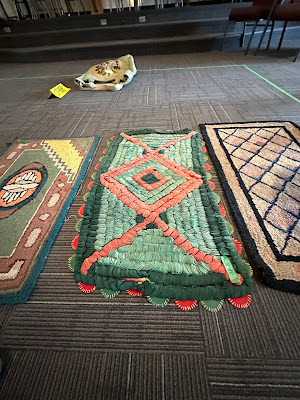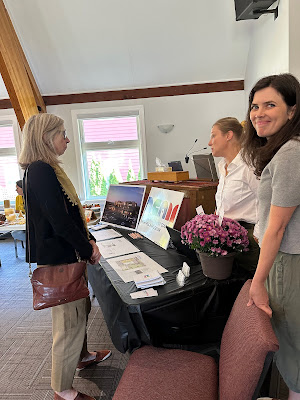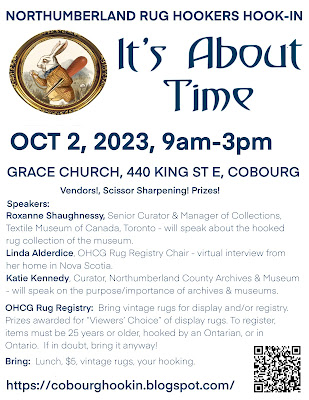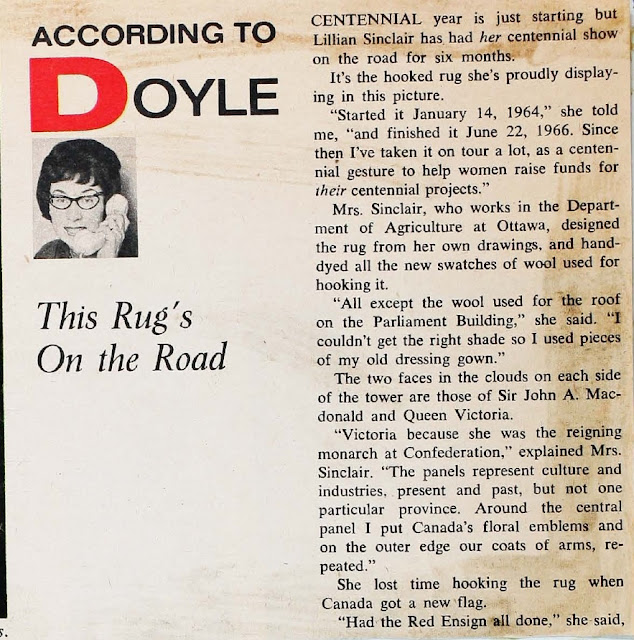Included are a few snippets of our video interview of Linda Alderdice, Chair of the OHCG Heritage Rug Registry. This interview was shown at our recent Cobourg hook-in on October 2. In fact, if you’ve got 20 minutes to spare, HERE’S a link to the full video. Well worth a watch.
What is a heritage rug registry?
- A heritage rug registry is a database or catalogue of traditionally hooked rugs that are or appear to be 25 years old, or older. The database contains details about the person who created the rug, as well as details about the rug itself. Also included are 2 photographs: one of the rug, and one of the label, allowing us to match the photo with the descriptive details. Many provinces have their own rug registries.
Why register rugs?
- A registry serves to record the history and stories associated with a rug, a person and the community in which it was made. Every rug has a story associated with it, and if it is not recorded or passed down, that information is lost. A rug registry’s goal is to ensure those stories are not lost.
- As we learned from Katie Kennedy, Curator at the Northumberland County Archives and Museum, one of the speakers at our Cobourg event, so much of our history is written by and about prominent white males. By recording the stories of individual rug hookers (largely female) from our past we are attempting to right this imbalance.
- As folks learn about rug registries and their importance, there is a ‘snowball effect’ where more and more heritage items are identified and brought in to be registered.
Who are the rug hookers to be recorded?
- The OHCG’s Heritage Rug Registry aims to record the stories and rugs of items hooked by the residents of Ontario. These rugs could have been hooked elsewhere, but as long as they were hooked by an Ontarian, they are eligible. By the same token, a rug hooked in Ontario by a non-resident is also eligible.
What kinds of hooked items are recorded?
- Any item that has been traditionally hooked can be included. These include rugs/mats, trivets, bags, pillows, wall hangings, footstools, etc.
- The items must be at least 25 years old.
What is the information to be recorded?
- There is a form that can be used to record the details of a rug - available online at ohcg.org, or in paper/electronic form here.
- The details of the form includes:
- Owner contact information (and permission to register the rug)
- Hooker identification: dates of birth/death, place of residence, education, accomplishments, background, relationship to owner
- Hooked item information: where/when made, awards,
- Examination of the hooked item: condition, subject matter, size, materials used
- Note that in some instances where the rug has been acquired through a purchase (auction, yard sale, etc) the owner may not know any details. What little the owner does know should be recorded, and when the registered item is posted online, there’s a good chance that someone may recognize it, and supply the missing information.
- In some cases registered items may be transferred to another province’s registry if post registration research uncovers that it was not hooked in Ontario or by an Ontarian.
What is the registration process
- Registration can be done online, via the OHCG’s website, or it can be done in person at an event that is advertising the registry of vintage rugs:
In person:
- If registration is to be done in person at an event, the organizing branch should contact the OHCG’s Heritage Rug Registry to obtain blank labels and a bank of numbers to be used for the registry process.
- Care should be taken to ensure the security of all hooked items at the venue, and that only the designated owner can remove items at the end of the event.
- A rug registry at an event requires several specific roles. These can be distributed among several individuals or handled by a single person, depending on the number of items expected to be registered. The roles are:
- Interviewer: ensures the registration form is properly completed and assesses the state of the hooked item. Assigns a registration number.
- Sewer: attaches the label to the hooked item
- Photographer: photographs the front & back of the hooked item
- A registration form can be completed ahead of time (recommended) and brought to the event, or it can be completed on-site with an “interviewer”. If the form is completed ahead of time, the interviewer should ensure that as much info as possible is recorded. The interviewer should have a tape measure on hand.
- The interviewer assigns a registration number from the set of allotted numbers, records it on the form, and on a blank label.
- The label is attached to the reverse of the hooked item. Usually this is done with needle and thread, unless the item is framed.
- From there the item is photographed - both the front and back (showing the attached label)
- Upon completion of the rug registry event, the completed forms and photographs are submitted to the OHCG’s Heritage Rug Registry where the information is entered into their database.
- Before sending the info to the OHCG the branch volunteers will need to reconcile the photos with the completed forms and assigned numbers.
On-Line
- Forms may be completed and submitted online via the OHCG website.
- The submitter also provides a photograph of the hooked item at the time of registration.
- Upon receipt of the completed form and photo, the OHCG Heritage Rug Registry team reviews the submission to ensure its eligibility for registration.
- The team then mails a completed label to the owner who affixes it to the hooked item and returns a photograph of the reverse side of the item, clearly showing the label.
- Upon receipt of the final photograph the Heritage Rug Registry team adds the item to the registry database.
Hopefully you’ve been able to learn more about registries with this article and can see the value of such an undertaking! As Linda says, it’s not difficult! Why not consider hosting a rug registry at your next event? It could be as simple as a table with a volunteer to collect the stories….or it could be the whole enchilada like we did in Cobourg.
Also, don’t forget to register your own eligible rugs! Many OHCG members have lots of rugs that could (and should!) be included in the registry. You’re the best person to tell the stories of your rugs, so don’t let these tales get lost!
Here’s a collage of the rugs we registered on October 2:











































